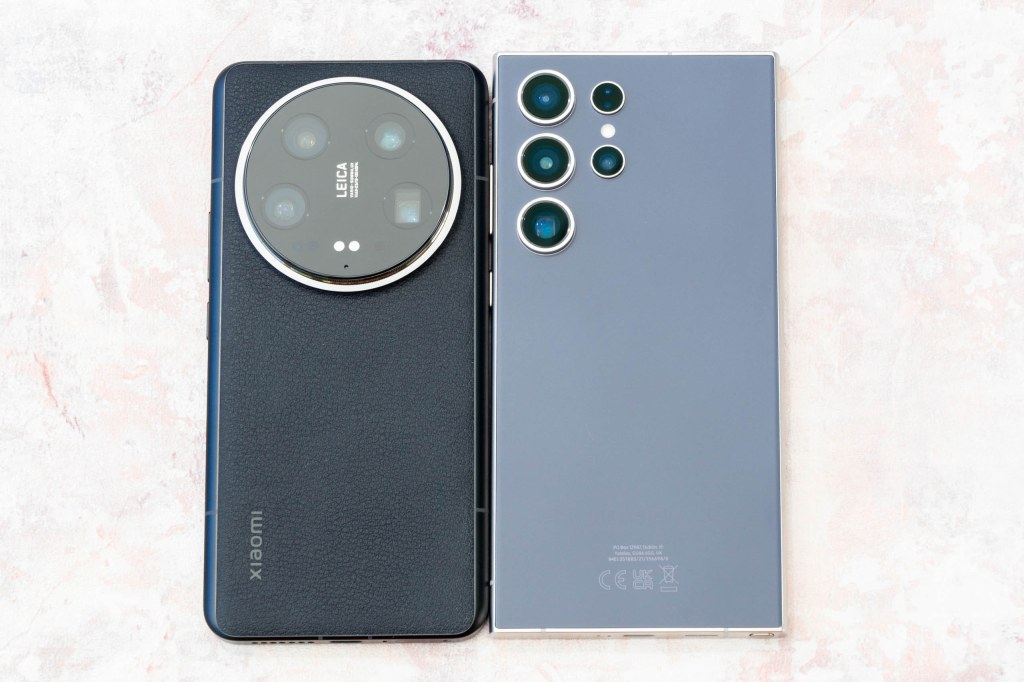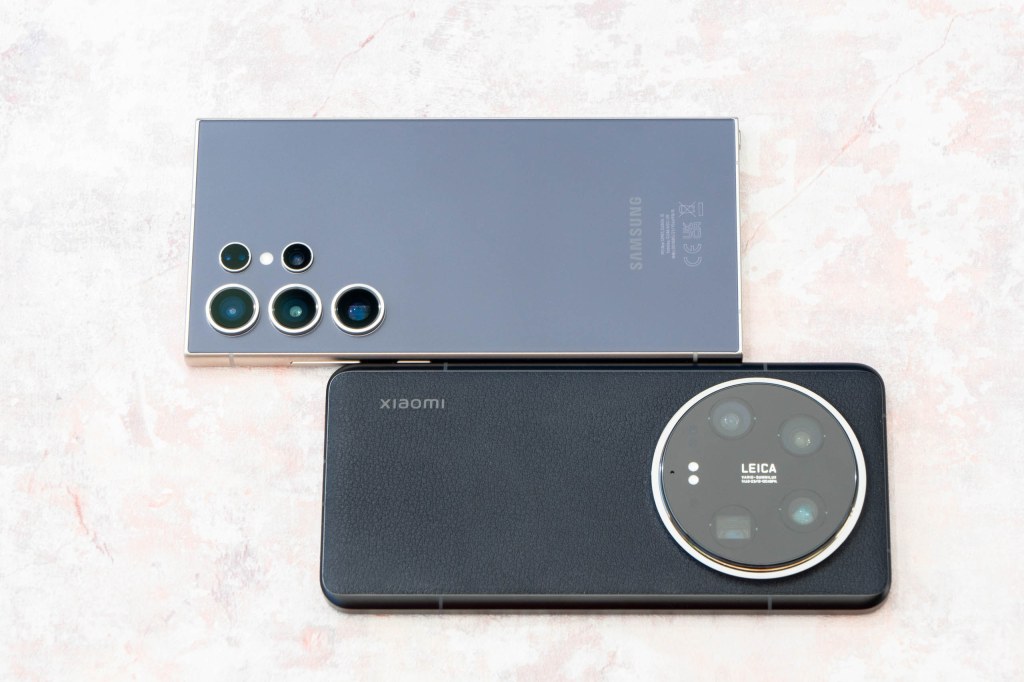Both the Samsung S24 Ultra and the Xiaomi 14 Ultra are sitting highly in our best smartphone for photographers list. Both offer a huge amount to those for whom the camera specs are super important, including quad lens set ups.
But, which is the best of the two? The Samsung is a more widely recognised name, but with the Xiaomi you get Leica expertise too, which is not to sniffed at.
Our individual reviews of these models found that both performed extremely well, but if we put them head to head can we find a winner? Let’s see what happens…
Samsung S24 Ultra vs Xiaomi 14 Ultra – Camera specs
As mentioned, both of these models have superb camera specifications for photographers. Both offer four different lenses for shooting with, which is something you don’t see on most phones.
With the Xiaomi 14 Ultra, impressively you get four 50MP sensors, each fronted by a Leica branded Summilux lens. On top of that, the main 1x (23mm equivalent) has a variable aperture of f/1.6-4 (something which is incredibly rare for smartphones), and it has a large 1-inch type sensor – another rarity. The main lens is joined by an ultrawide (12mm, f/1.8) and two telephoto lenses (75mm, f/1.8 and 120mm f/2.5). All of the other lenses here are 1/2.5” type.
Meanwhile, the Samsung S24 Ultra competes, but in different ways. It doesn’t have four 50MP sensors, but it does have one 200MP sensor, one 50MP sensor, and two lower resolution ones (12MP and 10MP). The main 1x (24mm equivalent) has a fixed f/1.7 aperture and is sitting in front of a 1/1.3” sensor. The other three lenses are an ultrawide (13mm equivalent, f/2, 1/2.55” 12MP sensor), plus two telephoto lenses (67mm, f/2.4, 1/2.55” 10MP sensor and 111mm, f/3.4, 1/2.52” 50MP sensor).
Both of the smartphones of course have selfie cameras, both have AF but the Xiaomi’s is a 32MP device, compared to the Samsung’s 12MP device.
It’s safe therefore to say that the on-paper specifications put the Xiaomi out in front here, but how will that translate in the real-world?
Samsung S24 Ultra vs Xiaomi 14 Ultra- Camera apps and shooting modes
Both being Android phones, both the Xiaomi 14 Ultra and the Samsung Galaxy S24 Ultra have pretty comprehensive native camera apps.
Starting with the Xiaomi, we have some everyday modes found in most phones, such as “Night” for shooting in low light, but there’s also a variation on a standard “Portrait” mode in that it can be used to recreate the look of shooting with Leica lenses. There’s also a “Pro” mode which you can use to change settings such as white balance, ISO, focus mode, and interestingly, aperture (if you’re using the 1x lens). You also need to shoot in this mode if you want to record in raw format.

It’s a fairly similar situation with the Samsung Galaxy S24 Ultra, which also has a Night mode, a Portrait mode (this time a fairly regular one), and not one, but two advanced shooting modes for those that want to take control of settings and shoot in raw format.
This one is a bit of a draw, as both are fairly similar – if you fancy the Leica lens recreation though, then it might draw you towards the Xiaomi.
Samsung S24 Ultra vs Xiaomi 14 Ultra – General image quality
You can capture great images with both of these models, in a wide range of different shooting conditions. The best results tend to be when shooting in good light, and particularly when using the main (1x) lens.
In this scene, both the phones have captured a very pleasing image, but I think the Xiaomi has more pleasing – and more accurate colours – with the Samsung erring a little bit more towards greenish tones. Detail is great from both phones, with perhaps just a touch more visible from the Samsung. If you viewed both in isolation, both would look great though. With both phones, colours are well-matched between the four lenses on the whole.


The overall/general image quality from the Xiaomi 14 Ultra is great. Right:
The Samsung S24 Ultra also produces some excellent results. Image: Amy Davies
When artificial lighting is present in the scene, both do a great job again. The Xiaomi seems to have “corrected” the actual yellow tones that were there in real life to produce a more pleasing image, while the Samsung has stayed a little truer to reality – but they’re pretty close to each other.


The Samsung S24 Ultra has also corrected them somewhat, but stays a little bit truer to reality. Image: Amy Davies
Overall here we’ve got two very closely matched capabilities, both are great. It might be easier to pick out differences when looking more closely at specific shooting scenarios.
Samsung S24 Ultra vs Xiaomi 14 Ultra – Zoom
With two different telephoto lenses to choose from on both devices, you are well covered if you like to shoot reasonably distant subjects with either the Samsung or the Xiaomi. The telephoto lenses on both give you 3x or 5x zooming capabilities. However, on paper at least, the Xiaomi’s two telephoto lenses are better than the Samsung’s. Both of Xiaomi’s zoom lenses are 50MP, with one offering 75mm f/1.8 equivalent, and the other offering 120mm f/2.5 equivalent. The Samsung’s zoom lenses are 67mm f/2.4 (10MP) and 111mm f/3.4 (50MP).


Right: The same scene with the Samsung S24 Ultra’s 5x lens – still good, but slightly less detail. Image: Amy Davies
Both put in a fairly good performance from both lenses, but we can see if we look at 100% that the Xiaomi produces slightly more detailed results from its telephoto lenses (click to see Xiaomi’s 1x lens, and 3x lens for comparison). There is also better colour rendition from the Xiaomi lenses. Also check the Samsung’s 1x lens for comparison, plus the 3x lens.
It’s also worth noting that both models offer a huge maximum digital zoom reach – 100x zoom for the Samsung, and 120x zoom for the Xiaomi. It’s safe to say that neither are what you’ll actually want to use for much of the time, and are basically there as headline grabbers.
Overall, zoom performance is reasonably similar between the two in good light. I’d just about give the edge to Xiaomi, but there’s not a huge amount in it.
Samsung S24 Ultra vs Xiaomi 14 Ultra – Low Light
Both these phones have night modes, with both of them automatically activating when low light is detected. You can also manually select a Night mode with both phones too.


Left: An example of low-light performance from the Xiaomi 14 Ultra.
Right: The same shot with the Samsung S24 Ultra . Image: Amy Davies
The light in this scene was very low, so it’s impressive what both phones have managed to pick up, however there’s quite a difference between the two. The Samsung image is brighter and more vibrant, while the Xiaomi’s is probably a bit closer to how things look in reality.
With the ultrawide lens, the Xiaomi puts in a better performance than the Samsung in terms of detail rendered, with the same sort of disparity between the colours shown.
In very low light like this, the Samsung seems to use the 1x lens and perform a crop rather than using the actual 3x telephoto lens. As a result, the images from the Xiaomi are much better. At 5x, the Samsung does use the 5x lens, so the results are a bit closer between the two 5x lenses, but I’d still give the Xiaomi the edge.
Samsung S24 Ultra vs Xiaomi 14 Ultra – Macro
Both the Xiaomi and Samsung are excellent for close-up photography. Both automatically activate a macro mode if you get close to a subject, but it’s only the Xiaomi which has a floating telephoto lens which is specifically designed for this purpose.
In this test, the Samsung has used the main lens (1x) and cropped to produce an angle of view similar to shooting with the 3x lens – which I chose to create a nice clean close-up of the Lego figure. The Xiaomi by contrast has used the floating telephoto. They’re both great results, but the Xiaomi has a little more detail and the background is more pleasing.


Right: The S24 Ultra is also very good for macro work. Image: Amy Davies
It’s fairly close between the two here, with both being great for macro photography – but again it’s the Xiaomi which has the edge.
Samsung S24 Ultra vs Xiaomi 14 Ultra – Portrait
Many of the flagship smartphones are great for portraits, and these two models are no different. While both produce great results, the Samsung tends to be a bit softer in the default mode, which can be more flattering – but the detail picked up by the Xiaomi is impressive. The outlines around the hair in the Xiaomi portrait are probably a little bit more natural too.


Right: A portrait shot with the Samsung S24 Ultra. Image: Amy Davies
It’s hard to pick a winner between these two portraits – the Xiaomi is more accurate, but the Samsung is potentially more flattering with its warmer tones and slightly softer look. Which you prefer can be quite subjective.


Right: A selfie with the Samsung S24 Ultra. Image: Amy Davies
The selfie camera on the Xiaomi has produced a crisper result again, though are both are fairly flattering – again we have nicer/warmer tones from the Samsung. The outline in the selfie picture is probably a little bit better with the Xiaomi.
With both models you have the opportunity to change the focus point after the fact if you’re not happy with whatever the phone has chosen, so that’s good news.
Both models are great for portraits so I’d loosely call this one a draw. However, if you prefer warmer tones, then the Samsung is better. If you prefer accuracy, go for the Xiaomi.
Samsung S24 Ultra vs Xiaomi 14 Ultra – Video
Those who like to shoot video have great options with both of these phones. You’ve got 8K capability from both of them, as well as the more widely used 4K options. With the Xiaomi 14 Ultra, you can even shoot at 120fps at 4K, while the Samsung tops out at 60fps for 4K.
Both have standard video recording modes, as well as more in-depth options to shoot with, depending on what it is you want to do. Both would make excellent options for content creators, as well as those who just like to record videos off-the-cuff to accompany their photography.
I’d have to place it as a bit of draw between these two Android models here for video.
Samsung S24 Ultra vs Xiaomi 14 Ultra – Screen and Design
Both of these phones are on the “large” side, but it’s the S24 Ultra that is the biggest with its 6.8” screen – in fact it’s one of the largest on the market. The Xiaomi isn’t that much smaller though, at 6.73”.
Resolutions between the two screens are fairly similar – 3200 x 1440 for the Xiaomi and 3120 x 1440 for the Samsung. Both have a refresh rate of 120Hz, while the Xiaomi has a slightly higher peak brightness at 3000 nits (2572 nits for the Samsung). Both are AMOLED devices.

The real highlight here though for me is the anti-glare coating of the Samsung. It’s striking in our picture here – you can see that the Samsung appears pure matte black, compared to the much shinier reflective screen of the Xiaomi. This might not be a deal breaker – in fact it’s not something I knew I wanted until I saw it in the flesh – it’s really great at helping you to see your phone in brighter conditions.
Other design specifications include both having IP68 waterproofing, and both having tough credentials – “Xiaomi Shield Glass” for the 14 Ultra, and the more familiar Corning Gorilla Armour for the Samsung S24 Ultra. Either way, both have withstood scratches well during my time with them.

Aesthetically, the two depart from each other quite a bit. Which you prefer is subjective. The Xiaomi has a round lens housing on the back which arguably makes it look a bit more like a “real” camera, while Samsung has been using pretty much the same design for the S series for some time.
Overall, in terms of design, the duo are fairly evenly matched, but I’d just about give it to Samsung for that anti-glare screen.
Samsung S24 Ultra vs Xiaomi 14 Ultra – Battery life, charging and storage
Both the phones here have a 5000mAh battery, with both offering quick charging and wireless charging functionality. You will need to buy a charger whichever one you buy, and you’ll need to make sure you have special wireless or fast chargers if you specifically want to do that. However you charge these phones, both easily last a full day even with reasonably heavy usage – sometimes I’ve been able to make it two days for either one.
There is only one storage option for the Xiaomi, which is 512GB. That level of storage should be ample for almost every user, apart from perhaps very active content creators. By contrast, with the Samsung you can either drop down to 256GB or up to 1TB, as well as a 512GB option, so there’s more choice there depending on what you think you might need.
Samsung S24 Ultra vs Xiaomi 14 Ultra – Price
With there being only one storage option for the Xiaomi, there is also only one price point. The 14 Ultra will set you back £1299. That makes it marginally more expensive than the cheapest Samsung S24 Ultra, which costs £1249 – but only gets you 256GB worth of storage.
Like for like, the 512GB S24 Ultra costs £1349, so it’s the Xiaomi which is the better value – at least in terms of storage options. If you want the 1TB Samsung S24 Ultra, then you will be looking at a £1549 bill.
Samsung S24 Ultra vs Xiaomi 14 Ultra – Verdict
It’s safe to say that both of these smartphones are excellent flagship devices, with both producing fantastic photos and videos in a wide range of conditions.
But we’re here to find out which is the best. As ever, it’s a tricky one to definitively decide, as some of it comes down to subjective preferences over colour and so on.
However, overall, image quality seems to be better from the Xiaomi 14 Ultra, with particularly honourable mention for macro which is probably the best I’ve ever seen from a smartphone. Low light is very good too, as is portrait. That’s not to say that the Samsung is bad – it’s very much not – but I’m here to be as picky as I can be.
When it comes to price, there’s two ways you can look at this. Yes, the Samsung is more expensive on a like-for-like basis. However, when you come to sell on your smartphone, you’ll almost certainly get more for a well-known brand like Samsung than a Xiaomi, so in the long run, it will be better value. But, if you’re looking to save cash right now, the Xiaomi is the one for you.
It’s hard work coming up with a winner in these group tests and these two phones are very close indeed. Both are excellent, and both will certainly give you great results – but the Xiaomi 14 Ultra ultimately takes the crown as the best smartphone for photographers.
Related content:
- iPhone 15 Pro Max vs Xiaomi 14 Ultra: Cameras compared
- iPhone 15 Pro Max vs Samsung Galaxy S24 Ultra: Cameras compared
- Smartphone vs Digital Camera: Which is better?
- Xiaomi 13T Pro Review – Leica on a budget
Follow AP on Facebook, Twitter, Instagram, YouTube and TikTok.










